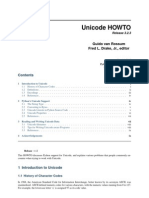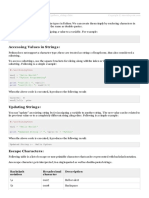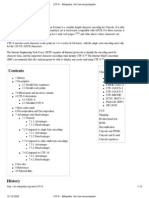Python Unicode Objects
Uploaded by
robert_silva8458Python Unicode Objects
Uploaded by
robert_silva8458Python Unicode Objects http://effbot.org/zone/unicode-objects.
htm
Pyt h on U n i cod e Obj ect s
Som e Obser vat i on s on W or k i n g W i t h N on -ASCI I
Ch ar act er Set s
This note pr ovides some br ief infor mation on best pr actices for wor king with
non-ASCI I data in Python 2.0 and later . As ever ything else on this site, this is
a wor k in pr ogr ess.
Updated June 21, 2004 | February 11, 2002 | Fredrik Lundh
Pythons Unicode string type stores characters from the Unicode character set.
In this set, each distinct character has its own number, the code point.
Unicode supports more than one million code points. Unicode characters
dont have an encoding; each character is represented by its code. The Unicode
string type uses some unknown mechanism to store the characters; in your
Python code, Unicode strings simply appear as sequences of characters, just
like 8-bit strings appear as sequences of bytes.
Observations:
1. Text files always contain encoded text, not characters. Each character in
the text is encoded as one or more bytes in the file.
2. Most popular encodings (UTF-8, ISO-8859-X, etc) are supersets of
ASCII. This means that the first 128 characters have the usual meaning,
and that the usual characters are used for line endings. In other words,
r eadl i n e( ) will work just fine.
3. You can mix Python Unicode strings with 8-bit Python strings, as long
as the 8-bit string only contains ASCII characters. A Unicode-aware
library may chose to use 8-bit strings for text that only contains ASCII,
to save space and time.
4. If you read a line of text from a file, you get bytes, not characters.
5. To decode an encoded string into a string of well-defined characters,
you have to know what encoding it uses.
6. To decode a string, use the decode( ) method on the input string, and
pass it the name of the encoding:
fileencoding = "iso-8859-1"
raw = file.readline()
txt = raw.decode(fileencoding)
(the result is a Python Unicode string).
1 de 2 11/04/2017 09:10 p.m.
Python Unicode Objects http://effbot.org/zone/unicode-objects.htm
The decode method was added in Python 2.2. In earlier versions (or if
you think it reads better), use the u n i code constructor instead:
txt = unicode(raw, fileencoding)
7. Pythons regular expression engine supports Unicode. You can apply
the same pattern to either 8-bit (encoded) or Unicode strings. To create
a regular expression pattern that uses Unicode character classes for \ w
(and \s, and \b), use the (?u) flag prefix, or the r e.U N I COD E flag:
pattern = re.compile("(?u)pattern")
pattern = re.compile("pattern", re.UNICODE)
8. To write a Unicode string to a file or other device, you have to convert it
to the encoding used by the file. The en code method converts from
Unicode to an encoded string.
out = txt.encode(encoding)
If the string contains characters that cannot be represented in the given
encoding, Python raises an exception. You can change this by passing in
a second argument to en code:
# s k i p bad c har s
out = txt.encode(encoding, "ignore")
# r epl ac e bad c har s wi t h " ?"
out = txt.encode(encoding, "replace")
For more on string encoding, see Conver ting Unicode Str ings to 8-bit
Str ings.
9. To print a Unicode string to your output device, you have to convert it
to the encoding used by your terminal. The en code( ) method converts
from Unicode back to an encoded string. You can use the
l ocal e.get def au l t l ocal e( ) function to get the current output
encoding.
i mpor t locale
language, output_encoding = locale.getdefaultlocale()
pr i nt txt.encode(output_encoding)
Ther e ar e lots of shor tcuts in Python, including coded str eams, using default
locales for patter n matching, I SO-8859-1 as a subset of Unicode, etc, but
thats outside the scope of this note. At least for the moment.
rendered by a django application. hosted by webfaction.
2 de 2 11/04/2017 09:10 p.m.
You might also like
- Unicode HOWTO: Guido Van Rossum and The Python Development TeamNo ratings yetUnicode HOWTO: Guido Van Rossum and The Python Development Team13 pages
- Unicode HOWTO: Guido Van Rossum and The Python Development TeamNo ratings yetUnicode HOWTO: Guido Van Rossum and The Python Development Team12 pages
- Introduction To Unicode: History of Character CodesNo ratings yetIntroduction To Unicode: History of Character Codes4 pages
- Unicode in C++ - McNellis - CppCon 2014No ratings yetUnicode in C++ - McNellis - CppCon 2014125 pages
- Introduction-to-Encoding-and-Decoding (1)No ratings yetIntroduction-to-Encoding-and-Decoding (1)10 pages
- Week 4 - A Comparative Study of UTF-8 UTF-16 and UTF-32No ratings yetWeek 4 - A Comparative Study of UTF-8 UTF-16 and UTF-3212 pages
- Unicode & Character Encodings in Python - A Painless Guide - Real PythonNo ratings yetUnicode & Character Encodings in Python - A Painless Guide - Real Python20 pages
- Ruby Conf 2006: I18N, M17N, Unicode, and All ThatNo ratings yetRuby Conf 2006: I18N, M17N, Unicode, and All That60 pages
- 3 Python Fundamentals m02 Strings SlidesNo ratings yet3 Python Fundamentals m02 Strings Slides76 pages
- Python Strings: Accessing Values in String SNo ratings yetPython Strings: Accessing Values in String S7 pages
- Utf-8 - Wikipedia, The Free EncyclopediaNo ratings yetUtf-8 - Wikipedia, The Free Encyclopedia10 pages
- An Introduction To Python For Absolute BeginnersNo ratings yetAn Introduction To Python For Absolute Beginners457 pages
- Mastering Python Programming: A Comprehensive Guide: The IT CollectionFrom EverandMastering Python Programming: A Comprehensive Guide: The IT Collection5/5 (1)
- Applied Statistics in Business and Economics 4th Edition Doane Test Bank instant download100% (5)Applied Statistics in Business and Economics 4th Edition Doane Test Bank instant download55 pages
- Design A Dynamic Sliding Mode ControllerNo ratings yetDesign A Dynamic Sliding Mode Controller8 pages
- Lab 02 - Getting Familier To Ladder Logic ProgrammingNo ratings yetLab 02 - Getting Familier To Ladder Logic Programming12 pages
- Adding Eccentricity Using - Coefficient Lateral Force - Computers and Structures - ETABS - Eng-TipsNo ratings yetAdding Eccentricity Using - Coefficient Lateral Force - Computers and Structures - ETABS - Eng-Tips2 pages
- Quiz 3 - Discrete Probability DistributionNo ratings yetQuiz 3 - Discrete Probability Distribution3 pages
- Portfolio Selection: Optimizing An Error: Assignment #1 (Based On Case From Textbook)No ratings yetPortfolio Selection: Optimizing An Error: Assignment #1 (Based On Case From Textbook)10 pages
- Speaker-Independent Phone Recognition Using Hidden Markov Models PDFNo ratings yetSpeaker-Independent Phone Recognition Using Hidden Markov Models PDF8 pages
- Ludovica Cotta-Ramusino - A Path-Integral Formalism of DNA Looping ProbabilityNo ratings yetLudovica Cotta-Ramusino - A Path-Integral Formalism of DNA Looping Probability122 pages
- Leibniz's Spark of Kant's Great Light:: An Application of Castaneda's Darwinian Approach To The History of PhilosophyNo ratings yetLeibniz's Spark of Kant's Great Light:: An Application of Castaneda's Darwinian Approach To The History of Philosophy8 pages
- Fluent 6.3: Population Balance Module ManualNo ratings yetFluent 6.3: Population Balance Module Manual55 pages
- 110325 - Bài Tập Tree Digram ProbabilityNo ratings yet110325 - Bài Tập Tree Digram Probability8 pages
- The Cambridge Sr. Sec. School Paper 25 MathsNo ratings yetThe Cambridge Sr. Sec. School Paper 25 Maths5 pages
- Fox Fluid Mechanics 8th Solved Problem 3.13No ratings yetFox Fluid Mechanics 8th Solved Problem 3.132 pages
- Biostatistics 4th Year Rates Ratios Proportions 1326731088 Phpapp02 120116104238 Phpapp02No ratings yetBiostatistics 4th Year Rates Ratios Proportions 1326731088 Phpapp02 120116104238 Phpapp0246 pages
- Ingen Dynamics - Programming Aptitude AssessmentNo ratings yetIngen Dynamics - Programming Aptitude Assessment3 pages
- Continuous Wavelet Transform Coeff - Matlab CodeNo ratings yetContinuous Wavelet Transform Coeff - Matlab Code8 pages

























































































